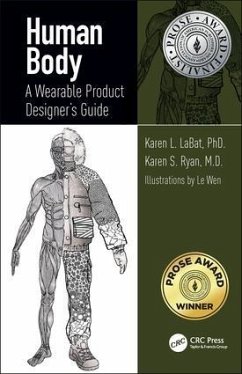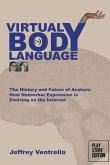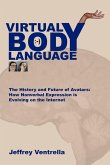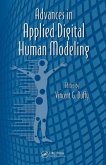- Gebundenes Buch
- Merkliste
- Auf die Merkliste
- Bewerten Bewerten
- Teilen
- Produkt teilen
- Produkterinnerung
- Produkterinnerung
This book is written to provide designers with realistic, reliable knowledge of human anatomy from a design perspective. This book will provide not only an everyday resource for wearable product designers, but also a resource for students designing wearable products.
Andere Kunden interessierten sich auch für
![No-Body Homicide Cases No-Body Homicide Cases]() Thomas A. Dibiase (Tad)No-Body Homicide Cases70,99 €
Thomas A. Dibiase (Tad)No-Body Homicide Cases70,99 €![Virtual Body Language Virtual Body Language Virtual Body Language Virtual Body Language]() Jeffrey VentrellaVirtual Body Language Virtual Body Language21,99 €
Jeffrey VentrellaVirtual Body Language Virtual Body Language21,99 €![Virtual Body Language Virtual Body Language]() Jeffrey VentrellaVirtual Body Language20,99 €
Jeffrey VentrellaVirtual Body Language20,99 €![Privacy Preserving Scheme for Body Sensor Networks Based on CDLP Privacy Preserving Scheme for Body Sensor Networks Based on CDLP]() Gulzar MehmoodPrivacy Preserving Scheme for Body Sensor Networks Based on CDLP24,99 €
Gulzar MehmoodPrivacy Preserving Scheme for Body Sensor Networks Based on CDLP24,99 €![Advances in Applied Digital Human Modeling Advances in Applied Digital Human Modeling]() Advances in Applied Digital Human Modeling251,99 €
Advances in Applied Digital Human Modeling251,99 €![Human-Robot Interactions in Future Military Operations Human-Robot Interactions in Future Military Operations]() Florian JentschHuman-Robot Interactions in Future Military Operations279,99 €
Florian JentschHuman-Robot Interactions in Future Military Operations279,99 €![Integrating Human Factors Methods and Systems Thinking for Transport Analysis and Design Integrating Human Factors Methods and Systems Thinking for Transport Analysis and Design]() Gemma J. M. ReadIntegrating Human Factors Methods and Systems Thinking for Transport Analysis and Design100,99 €
Gemma J. M. ReadIntegrating Human Factors Methods and Systems Thinking for Transport Analysis and Design100,99 €-
-
-
This book is written to provide designers with realistic, reliable knowledge of human anatomy from a design perspective. This book will provide not only an everyday resource for wearable product designers, but also a resource for students designing wearable products.
Hinweis: Dieser Artikel kann nur an eine deutsche Lieferadresse ausgeliefert werden.
Hinweis: Dieser Artikel kann nur an eine deutsche Lieferadresse ausgeliefert werden.
Produktdetails
- Produktdetails
- Verlag: CRC Press
- Seitenzahl: 694
- Erscheinungstermin: 22. Februar 2019
- Englisch
- Abmessung: 240mm x 161mm x 41mm
- Gewicht: 1195g
- ISBN-13: 9781498755719
- ISBN-10: 1498755712
- Artikelnr.: 55432811
- Herstellerkennzeichnung
- Libri GmbH
- Europaallee 1
- 36244 Bad Hersfeld
- gpsr@libri.de
- Verlag: CRC Press
- Seitenzahl: 694
- Erscheinungstermin: 22. Februar 2019
- Englisch
- Abmessung: 240mm x 161mm x 41mm
- Gewicht: 1195g
- ISBN-13: 9781498755719
- ISBN-10: 1498755712
- Artikelnr.: 55432811
- Herstellerkennzeichnung
- Libri GmbH
- Europaallee 1
- 36244 Bad Hersfeld
- gpsr@libri.de
Karen L. LaBat, PhD, is Horace T. Morse Distinguished Professor Emerita, College of Design, University of Minnesota. She was instrumental in establishing the Wearable Product Design Center and the Human Dimensioning(c) Laboratory at the University of Minnesota. Her research focus is product development for human health and safety and study of the body to improve function and fit of wearable products. Research funding sources include: National Science Foundation, 3M, U of MN Clinical and Translational Science Institute, U of MN Institute for Advanced Study, and others. She has published in Applied Ergonomics; Australasian Medical Journal; Ergonomics; Clothing and Textiles Research Journal; Journal of the Textile Institute; International Journal of Fashion Design, and Technology ; and other journals. She was co-editor for the Clothing and Textiles Research Journal Focused Issue on Fashion and Health, co-editor of the Clothing and Textiles Research Journal Focused Issue on Research and Teaching in the 21st Century, and an associate editor for Fashion and Textiles-the Journal of the Korean Society of Clothing and Textiles, and served on the editorial board of the Journal for Health Design. She was co-chair of the U of MN, College of Design, Fashion and the Body 2016 Symposium. Her awards include: International Textiles and Apparel Association Distinguished Scholar, U of MN College of Design Outstanding Research Award, Lectra Innovation Award for Faculty Research, and U of MN College of Design Innovation and Mission Advancement Award. Dr. LaBat received the 2013 U of MN Horace T. Morse Award for Excellence in Undergraduate Teaching and was inducted into the Academy of Distinguished Teachers. Karen S. Ryan, M.D., M.S. has been a Research Associate with the Human Dimensioning(c) Laboratory, University of Minnesota, since she completed her Masters of Science in Apparel in 2006, with a project on designing apparel for women with posture changes from osteoporosis. Her research grew from her longstanding interest in apparel design and her clinical and teaching practice as a specialist in Physical Medicine and Rehabilitation (PM&R). Her clinical practice focused on musculoskeletal issues, electromyography (EMG), and neurological rehabilitation, with a strong emphasis on patient education. She has served on the faculty of the Department of Physical Medicine and Rehabilitation, University of Minnesota Medical School, including as the Director of the Electromyography Service and as Residency Training Director. She has been an Oral Examiner for the American Board of Physical Medicine and Rehabilitation and the American Board of Electrodiagnostic Medicine. She has made numerous PM&R presentations on a wide range of topics and in many venues, from patient family education sessions to University of Minnesota Television to national PM&R and EMG meetings. She has presented her design and health research in local, national, and international meetings and published in the medical and apparel design literature. Illustrator Biography Le "Lettie" Wen graduated from Tsinghua University, China with a Masters of Literature. She began work on illustrations for this book as a graduate research assistant in the Human Dimensioning Laboratory(c) at the University of Minnesota. She received a master's degree in Graphic Design from the University of Minnesota in 2017. Her graduate thesis, titled "Human Anatomy for Wearable Product Designers," combined knowledge from the fields of anthropometry and medical illustration. She developed a unique style to portray the interactions of the human body and a product. She plans to continue work as an illustrator, with an emphasis on anatomical illustration.
The Human Body as Foundation for Developing Wearable Products. Total Body
Systems: The basics. Designing Wearable Products for the Head and Neck.
Designing Wearable Products for the Upper Torso and Limbs. How to landmark
and Measure Lower Torso and Limbs. The Waistline: finding, measuring, and
fitting the ever changing landmark. Designing for Hands and Wrists.
Designing for Feet and Ankles. Designing for the Total Body. Designing for
a Lifetime: Infant through oldest adult.
Systems: The basics. Designing Wearable Products for the Head and Neck.
Designing Wearable Products for the Upper Torso and Limbs. How to landmark
and Measure Lower Torso and Limbs. The Waistline: finding, measuring, and
fitting the ever changing landmark. Designing for Hands and Wrists.
Designing for Feet and Ankles. Designing for the Total Body. Designing for
a Lifetime: Infant through oldest adult.
The Human Body as Foundation for Developing Wearable Products. Total Body
Systems: The basics. Designing Wearable Products for the Head and Neck.
Designing Wearable Products for the Upper Torso and Limbs. How to landmark
and Measure Lower Torso and Limbs. The Waistline: finding, measuring, and
fitting the ever changing landmark. Designing for Hands and Wrists.
Designing for Feet and Ankles. Designing for the Total Body. Designing for
a Lifetime: Infant through oldest adult.
Systems: The basics. Designing Wearable Products for the Head and Neck.
Designing Wearable Products for the Upper Torso and Limbs. How to landmark
and Measure Lower Torso and Limbs. The Waistline: finding, measuring, and
fitting the ever changing landmark. Designing for Hands and Wrists.
Designing for Feet and Ankles. Designing for the Total Body. Designing for
a Lifetime: Infant through oldest adult.








